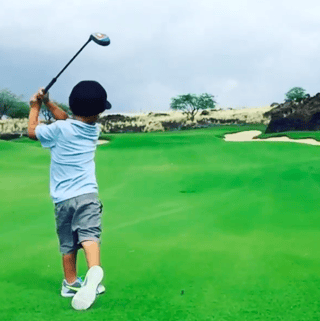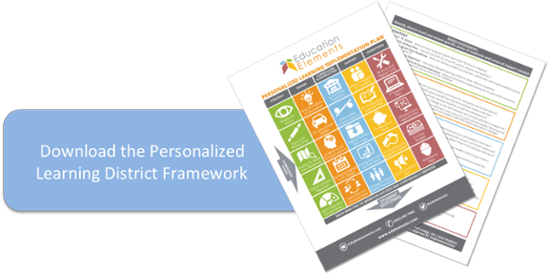
Rearing a competitive golfer is an incredibly difficult challenge—especially for families of average income. Most golfers who compete at the highest levels belong to private country clubs and have swing coaches, performance coaches (mental side of the game), and personal fitness trainers. They also have professional caddies who travel with their players all over the country and world. And this begins at around the age of 6!
Education has similar access issues. The most affluent families hire full-time academic tutors to provide one-on-one instruction, introduce their students to a variety of educational experiences through travel, and even send their children to prestigious schools such as Phillips Exeter Academy. How can a family of average means compete in an environment that provides a clear advantage to very wealthy families?
Working as the Director of Instructional Technology in Greeley-Evans School District 6 in Colorado, I have the unique role of working with schools to fundamentally transform the architecture of teaching and learning to create personalized learning environments. I have done so in a school district that is not particularly affluent or cash-rich. These experiences have led me to think about how to provide my son access to the highest-quality golf instruction without millions of dollars to support his training. The answer, I believe, is blended learning.
As we have implemented blended models in our schools in Greeley and Evans, we have noticed that the most successful models have four critical components in common:
- Student ownership - Students are clear about where they are in their learning progression and become the drivers pushing to meet their own learning goals
- Tight feedback loops - Students receive immediate feedback using digital tools and teachers receive real-time data to inform instruction
- Targeted instruction - Students receive small-group & individual support tailored to their learning needs
- Quality student-to-student interaction - Students engage in sustained academic conversations with their peers
Before using a blended approach to support my son’s swing development, my son’s coach and I first used a traditional approach. His coach would watch him swing the club and then we would develop a step-by-step strategy to improve his swing. (Fortunately, my son started with some natural ability to swing the club so he only needed minor tweaks and not a painful swing overhaul that so many golfers must go through.) His coach would start by making a simple change to his grip that would put him in a better position to hit the ball. We would then spend hours on the driving range hitting balls to make this new grip feel natural. I would sit in a chair and drive my son crazy by providing him feedback on his grip after every swing, things like: “Your grip was perfect!” or “Trae, you moved your grip right before you took your backswing.” This wonderful feedback from his loving father would usually be greeted with a disgruntled response between gritted teeth of, “I did not!”
It was after some time that we decided to shift to an enhanced (or tech-rich) approach to further his development. After months of complete stupidity on my part, I finally realized I had a solution to this back-and-forth banter sitting in my pocket (a tech-enabled one!): I started filming my son using my iPhone camera. When I saw something was off, I would simply say, “Trae do you want to take a look at the video?” He would watch the video and immediately notice that he moved his hand. His response was now, “Oh man, I moved my grip again.” Progress….
The next step was working with his golf coach and filming his swing in slow motion to develop the next plan of action. The slow-motion video revealed parts of his swing that we could not see by simply watching or recording in real speed. He was pulling the golf club just a little bit inside on his swing which was causing some issues with the direction of his ball flight. By this point, the gig was up.
“Trae do you want to take a look at your golf swing on video?”
Nope.
He knew when I asked him to take a look at his swing that I had identified a problem in his approach.. I should have known to show him more of the ones he did correct as opposed to always correcting his errors! Feedback cannot always be corrective; it must also be affirmative. Lesson learned. This also carried over to the golf course. Trae would hit the ball off to the right and then look at me and ask why it went that way. My response would typically sound like, “You pulled it inside,” to which he would respond with an emphatic, “No I didn’t!”
The question in my mind became, like in any high-quality blended classroom, how do I get out of Trae’s way and allow him to take ownership of his golf swing and his learning? We found the answer to this question upon visiting the PGA Superstore. This has become Trae’s absolute favorite practice facility. He hits a ball into a screen where he sees an animated line of his ball flight against a 3-D backdrop. A tracker tells him the path of his club (inside, outside, or straight!), the distance the ball flew, the amount of backspin on the ball and his club speed while a camera recorded his swing in slow-motion! My role at the PGA Superstore is now to go over to the putting green and work on my own game and only occasionally checking-in to see if he needs more time on the simulator, additional help, or a Gatorade. I realized there was something very powerful about the non-judgmental feedback provided by the simulator. For Trae, the feedback didn’t feel so personal. The feedback didn’t have an opinion of good or bad,. No matter how neutral my tone or specific my feedback on the driving range, I couldn’t replicate the simulator. It was still irritating. I would say, “Straight back and on plane” which was almost always followed by a huff and head shake in disgust from Trae.
However, there are times that he will come and get me at the superstore. “Dad, it says I’m taking it outside rather than inside; I can’t figure it out--what’s happening?” I will then watch him hit a few balls and then we will go to the slow motion video. In this mentoring situation, Trae drives his own progress while I listen, ask questions, and offer support.
“What does it look like to you Trae?”
“I don’t know, I have been looking at it and I can’t see what’s causing it.”
“Trae take a look at your takeaway, do you notice anything?”
“Oh, I’m not turning my whole body, I’m just lifting my arms! I think you got it!”
There are other times that we can’t figure it out together. And so we email the slow-motion video to his swing coach and he will provide his analysis. This is usually greeted with, “Thanks coach!” Back to the simulator for more practice. At the end of his practice session, I email myself an excel spreadsheet directly from the simulator, which has recorded every single swing and all the analytics including his overall averages.
Now when I’m caddying for him the conversations are very different. When the ball goes to the right he simply looks at me and says, “Dad I think I pulled it inside.” This response is greeted with a smile from his dad and a nod of agreement. He now has all the tools he needs to self-diagnose on his performance assessment. He is the owner and driver (no pun intended!) of his learning.
Currently the sessions with his coach are a collaborative effort. We ask Trae what he wants to be able to do with the golf ball. We record his swing in slow-motion and then develop a plan as to how we can accomplish his goal. When we are all in agreement, we set to work with his coach on the range. Once he understands it with his coach and slow motion video on the range, we then spend the next four to six weeks trying to make this new motion a natural part of his golf swing.
One thing I would like to point out that influenced our model is dealing with the challenge of transfer. There is a significant lag between his new learning in practice and transferring those lessons learned to the golf course, especially, under tournament conditions (this is very similar to transferring math skills to solving novel problems). Even when everything looks perfect in practice, when he hits the course, the old habits start to slip back in. To overcome this lag between practice and game conditions, we have developed a rotational model. He practices at the PGA Superstore then we go to a driving range with real grass. On the range we try to make it as game-like as possible by having him hit his driver, then pick a flag on the driving range and hit an iron (to simulate game conditions), and then we go and play 3-holes (the actual application). We repeat this process all week and “test” his progress on the weekends at live tournaments! ! We then gather our data and plan practice for the next week, tweaking and adjusting the needed support as we move through the week.
By using a personalized philosophy and a blended approach over the past year, Trae has closed the gap between himself and the best players in the world by 10 strokes! I believe we can also level the playing field and close the achievement gap using a similar approach to academic subjects.
We definitely have room to grow with this model and will continue to iterate to get better at student ownership, targeted instruction, tight feedback loops, and quality student-to-student interactions. However, we have made significant progress toward personalization. Trae definitely feels more ownership over his learning. He is now in charge of the next steps and path that his swing development will take working in collaboration with his swing coach, caddie, and digital tools. The real-time feedback and data to track progress is phenomenal; he receives feedback in the moment on each swing and tracks his progress toward his ultimate goal. This has created an incredible combination of ownership and data that has given him complete clarity about where he is going and exactly where he is on his journey to achieve his goals. The feedback he gets from his dad/caddie is now much better because it’s timely and doesn’t feel nit-picky. The technology provides the feedback in a way that is viewed by Trae as completely non-judgemental. Dad is just there when something falls apart or when he needs additional mentoring. I’m more like a non-expert tutor: I can help him with little things to keep him going, but for highly-technical pieces of his swing, he elicits the expert eyes of his swing coach.
In a similar fashion, we educators have an enormous responsibility to help our students take ownership of their own learning. This process will require meaningful feedback, targeted instruction, and quality interactions. I believe that leveraging technology will assist us in facilitating these responsibilities by creating a personalized learning environment for each and every student. In this way, students in Greeley, Colorado will be able to access a world-class education---and perfect their golf swing.




